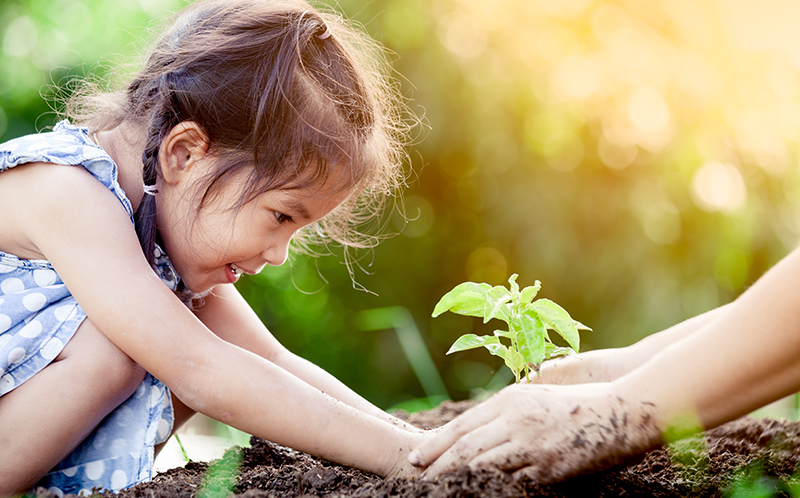
Cultivating a home garden is a great way to teach your children where their food comes from while fostering a sense of independence and a healthy respect for the environment. Most of all, it’s a fun activity the whole family can enjoy. Keeping their dexterity and attention span in mind, here are some tips on gardening with children that will get you growing in no time.
Location, Location, Location. The most important consideration when deciding what you want to grow is where you want to grow it. Are you planting indoors or out? In summer or fall? How much sun exposure will you have each day, and how extreme are the temperatures? Checking a hardiness map for your area will help you decide what, when, and where to grow, and involving your child in the research makes for a fun geography lesson.
Dig Up Some Dirt. To grow a successful garden, you need good soil. In an outdoor garden, you’ll want to till the soil to loosen it for planting. For indoor or container planting, a good potting soil right out of the bag will do. Get your little helper involved in this step by giving them a small trowel, or even a spoon, and encourage them to sift away. Use this opportunity to teach your child the correlation between organic soil and healthy food.
Big Seeds for Small Hands. Small children will feel a sense of accomplishment at being able to plant seeds all by themselves. Beans, corn, squash, and cucumbers have larger seeds that are easy to handle, making them great options for your child’s edible garden. If your child prefers flowers, nasturtiums and sweet peas are perfect for little green thumbs. Seedlings (that is, small starter plants) are also a great choice for children as they are easy to handle and provide the instant gratification of seeing green in the ground. Radishes and lettuce seeds sprout quickly, but are smaller, which may require more assistance.
Go in Depth. Just as important as what you plant is how you plant it. Carefully read the planting instructions on your seed packets and explain to your child how planting at the right depth and distance will help the plants grow strong. If you’re using seedlings, simply plant them at the same depth as they come out of the pot. If you’re planting a large outdoor garden, make sure to leave plenty of room between rows for you and your child to walk.
How Does Your Garden Grow? When you’ve finished planting, have your child help you label what you’ve planted, along with the date. Make this a fun project by painting stakes or popsicle sticks and marking them with permanent ink that won’t wear off in the elements. Your plant packages should state how long it takes your plants to germinate, so mark your calendar and tick down the days with your child to prolong the fun and build excitement.
A Meaningful Harvest. When your first vegetables or flowers are ready to pick, make a celebration of it. Have a special meal or family party incorporating the fruits of your child’s labor and congratulate your child on a job well done. Seeing tangible results from hard work is a great lesson for your child that will translate from the garden to the rest of their life pursuits while making wonderful memories along the way.
This post is intended for informational purposes only and should not be taken as professional advice. The point of view and opinions expressed in this post are those of the author and do not necessarily reflect the position of Realty Executives International. This post was written for Realty Executives by Estelle Weber, a freelance writer living in Los Angeles. You can read more of her work here.
